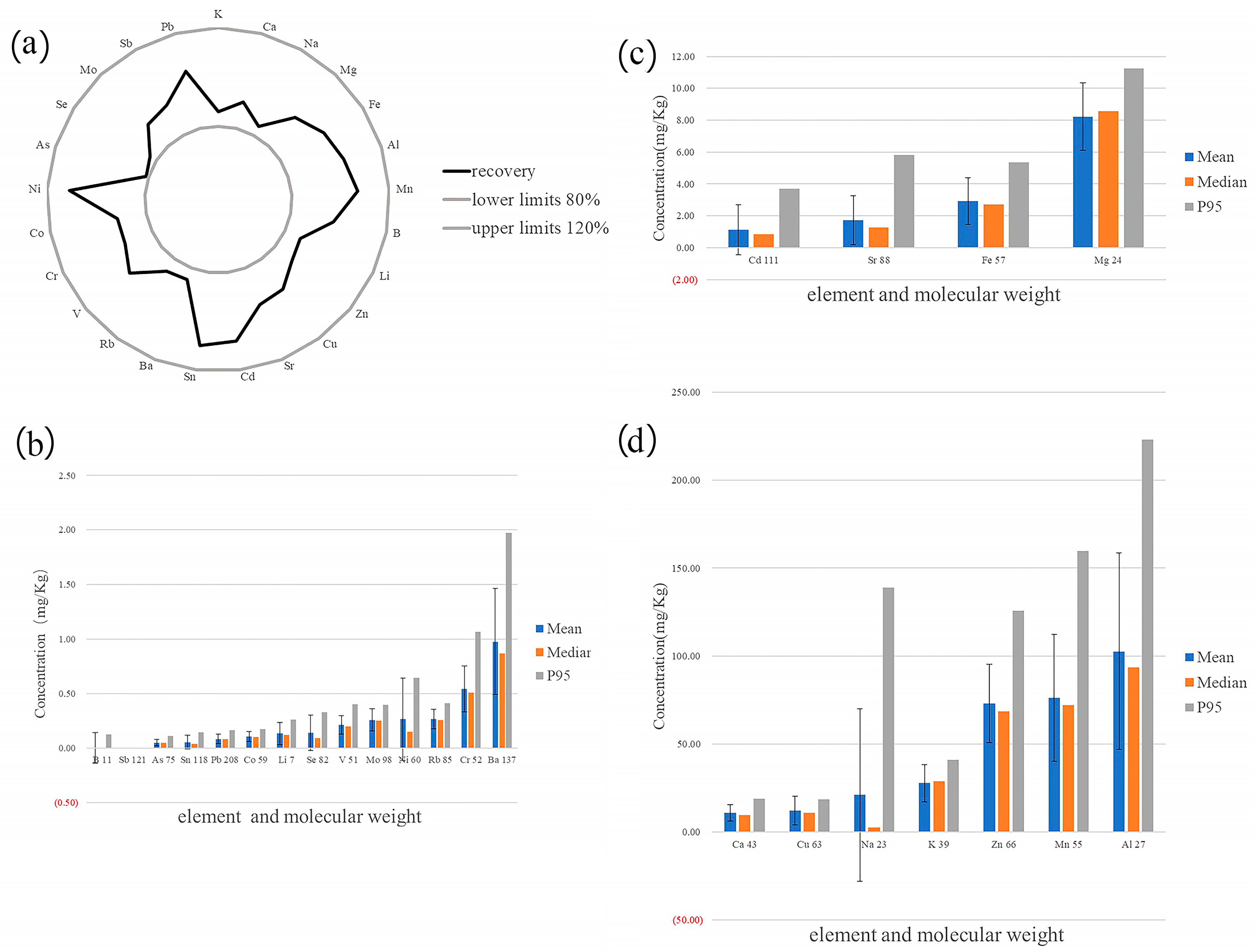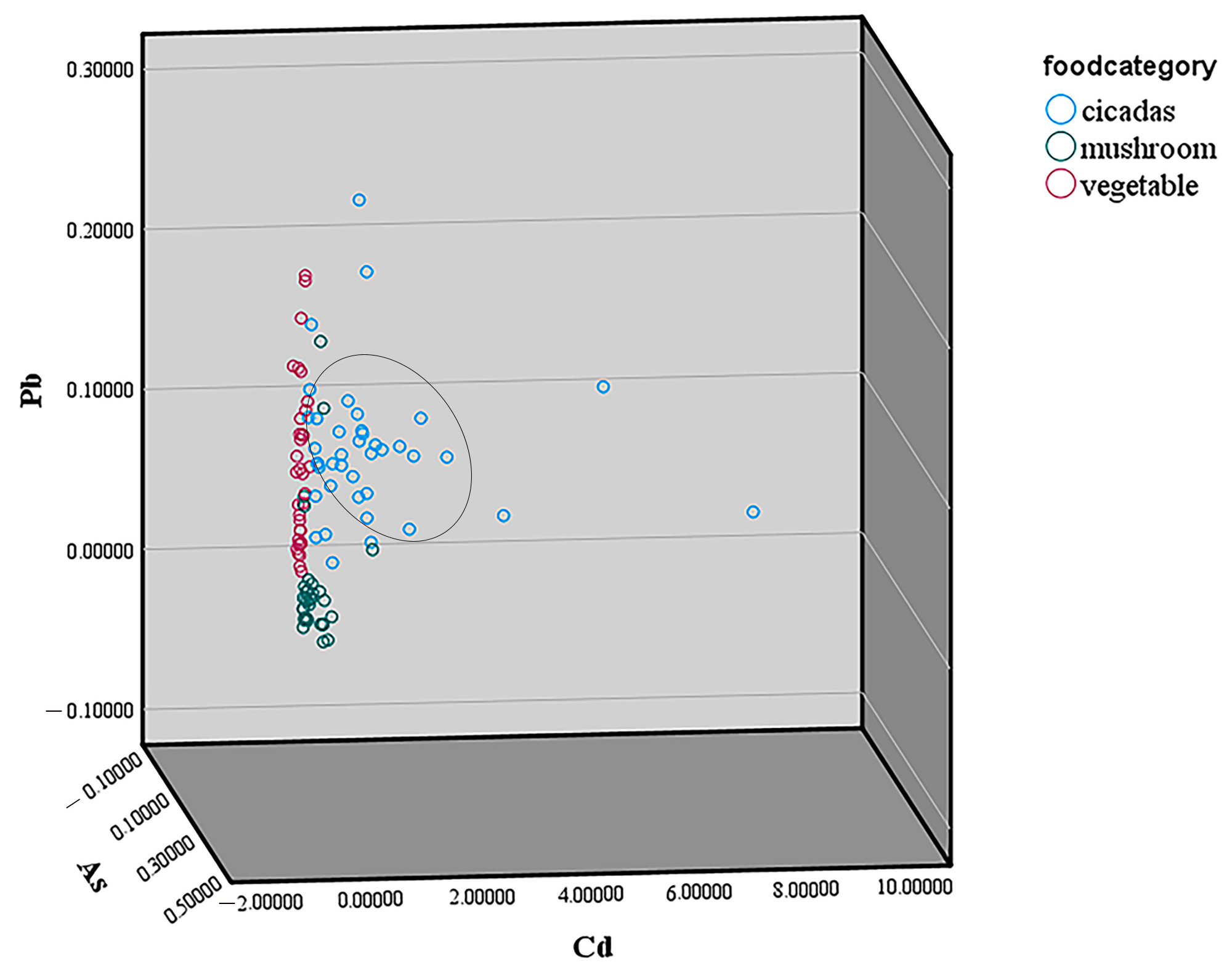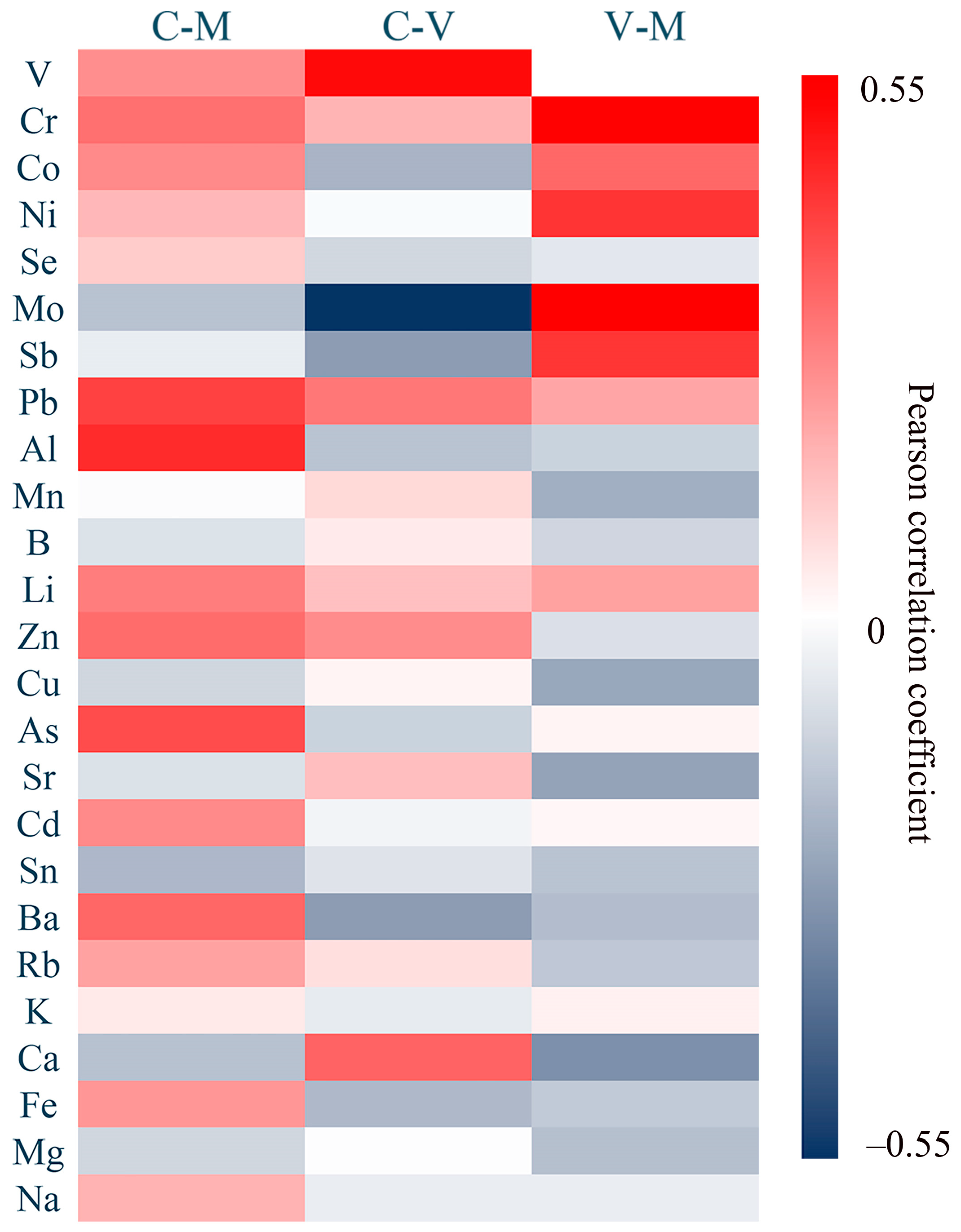Multielement Composition Analysis of Cicada as an Edible Insect and Dietary Risk Assessment
Abstract
1. Introduction
2. Materials and Methods
2.1. Chemicals, Standards, and Instruments
2.2. Sample Preparation
2.3. ICP-MS Condition
2.4. Method Validation
2.5. Dietary Risk Assessment
2.6. Data Analysis
3. Result and Discussion
3.1. Calibration Curves, MDL, and Recoveries
3.2. Multielements in Cicadas, Mushrooms, and Vegetables
3.3. Dietary Risk Assessment
3.4. Concentration of 3 Essential Elements
4. Conclusions
Supplementary Materials
Author Contributions
Funding
Institutional Review Board Statement
Informed Consent Statement
Data Availability Statement
Conflicts of Interest
References
- Srivastava, S.K.; Babu, N.; Pandey, H. Traditional insect bioprospecting—As human food and medicine. Indian J. Tradit. Knowl. 2009, 8, 485–494. [Google Scholar]
- Orsi, L.; Voege, L.L.; Stranieri, S. Eating edible insects as sustainable food? Exploring the determinants of consumer acceptance in Germany. Food Res. Int. 2019, 125, 108573. [Google Scholar] [CrossRef] [PubMed]
- Zielińska, E.; Zieliński, D.; Karaś, M.; Jakubczyk, A. Exploration of consumer acceptance of insects as food in Poland. J. Insects Food Feed. 2020, 6, 383–392. [Google Scholar] [CrossRef]
- Alam, A.; Abbas, S.; Ali, J. Diet suitability through biological parameters in Ostrinia furnacalis (Lepidoptera: Crambidae) clades. Entomol. Res. 2024, 54, 12751, Erratum in Entomol. Entomol. Res. 2024, 54, e12751. [Google Scholar] [CrossRef]
- Huis, A.; Van Itterbeeck, J.; Klunder, H.; Mertens, E.; Halloran, A.; Muir, G.; Vantomme, P. Edible Insects Future Prospects for Food and Feed Security; United Nations Digital Library: New York, NY, USA, 2013; Volume 171. [Google Scholar]
- Niassy, S.; Affognon, H.D.; Fiaboe, K.K.M.; Akutse, K.S.; Tanga, C.M.; Ekesi, S. Some key elements on entomophagy in Africa: Culture, gender and belief. J. Insects Food Feed. 2016, 2, 139–144. [Google Scholar] [CrossRef]
- FAO. How to Feed the World in 2050; Food and Agriculture Organization: Rome, Italy, 2009. [Google Scholar]
- Meyer-Rochow, V.B.; Pinent, M.; Costa Neto, E.M.; Grabowski, N.T.; Fratini, F.; Mancini, S. Editorial: Insects as Food and Feed. Front. Vet. Sci. 2022, 9, 873765. [Google Scholar] [CrossRef]
- Zhao, M.; Wang, C.-Y.; Sun, L.; He, Z.; Yang, P.-L.; Liao, H.-J.; Feng, Y. Edible Aquatic Insects: Diversities, Nutrition, and Safety. Foods 2021, 10, 3033. [Google Scholar] [CrossRef]
- Kalita, T.; Sharma, R.; Sengupta, S.; Basumatari, D. Entomophagy practices in Bodoland Territorial Region, Assam: Nutritional potential and implications for food security. J. Insects Food Feed. 2022, 8, 1485–1500. [Google Scholar] [CrossRef]
- Mishyna, M.; Fischer, A.R.H.; Steenbekkers, B.L.P.A.; Janssen, A.M.; Bos-Brouwers, H.E.J. Consumption and production of edible insects in an urban circularity context: Opinions and intentions of urban residents. Sustain. Prod. Consum. 2023, 42, 234–246. [Google Scholar] [CrossRef]
- Mishyna, M.; Chen, J.; Benjamin, O. Sensory attributes of edible insects and insect-based foods—Future outlooks for enhancing consumer appeal. Trends Food Sci. Technol. 2020, 95, 141–148. [Google Scholar] [CrossRef]
- Nishijo, M.; Nakagawa, H.; Suwazono, Y.; Nogawa, K.; Kido, T. Causes of death in patients with Itai-itai disease suffering from severe chronic cadmium poisoning: A nested case-control analysis of a follow-up study in Japan. BMJ Open 2017, 7, e015694. [Google Scholar] [CrossRef]
- Kumar, S.; Sharma, A. Cadmium toxicity: Effects on human reproduction and fertility. Rev. Environ. Health 2019, 34, 327–338. [Google Scholar] [CrossRef]
- Chi, H.; Zhang, Y.; Williams, P.N.; Lin, S.; Hou, Y.; Cai, C. In Vitro Model To Assess Arsenic Bioaccessibility and Speciation in Cooked Shrimp. J. Agric. Food Chem. 2018, 66, 4710–4715. [Google Scholar] [CrossRef]
- Mohammadyan, M.; Moosazadeh, M.; Khanjani, N.; Moghadam, S.R. Quantitative and semi-quantitative risk assessment of occupational exposure to lead among electrical solderers in Neyshabur, Iran. Environ. Sci. Pollut. Res. 2019, 26, 31207–31214. [Google Scholar] [CrossRef]
- Krewski, D.; Yokel, R.A.; Nieboer, E.; Borchelt, D.; Cohen, J.; Harry, J.; Kacew, S.; Lindsay, J.; Mahfouz, A.M.; Rondeau, V. Human health risk assessment for aluminium, aluminium oxide, and aluminium hydroxide. J. Toxicol. Environ. Health-Part B-Crit. Rev. 2008, 11, 147. [Google Scholar] [CrossRef]
- Han, J.; Zhang, R.; Tang, J.; Chen, J.; Zheng, C.; Zhao, D.; Wang, J.; Zhang, H.; Qi, X.; Wu, X.; et al. Occurrence and Exposure Assessment of Nickel in Zhejiang Province, China. Toxics 2024, 12, 169. [Google Scholar] [CrossRef]
- Woldetsadik, D.; Sims, D.B.; Huerta, E.H.; Nelson, T.; Garner, M.C.; Monk, J.; Hudson, A.C.; Schlick, K. Elemental profile of wheat in the las vegas market: Geographic origin discrimination and probabilistic health risk assessment. Food Chem. Toxicol. 2024, 191, 114862. [Google Scholar] [CrossRef]
- Desalew, A.; Zelelew, B.; Alemu, A.K.; Melese, A.T.; Assefa, A.G.; Negash, M.T.; Ayele, D.T.; Beshaw, T.; Akele, M.L. Profiling and health risk assessment of trace metal contents in bovine tissues: A case study in Gondar City, Ethiopia. J. Food Compos. Anal. 2024, 134, 106554. [Google Scholar] [CrossRef]
- Zhao, D.; Wang, P.; Zhao, F.-J. Toxic Metals and Metalloids in Food: Current Status, Health Risks, and Mitigation Strategies. Curr. Environ. Health Rep. 2024, 11, 468–483. [Google Scholar] [CrossRef] [PubMed]
- Lowe, N.M.; Hall, A.G.; Broadley, M.R.; Foley, J.; Boy, E.; Bhutta, Z.A. Preventing and Controlling Zinc Deficiency Across the Life Course: A Call to Action. Adv. Nutr. 2024, 15, 100181. [Google Scholar] [CrossRef]
- Kim, J.; Lee, J.; Ryu, M.-S. Cellular Zinc Deficiency Impairs Heme Biosynthesis in Developing Erythroid Progenitors. Nutrients 2023, 15, 281. [Google Scholar] [CrossRef]
- Gu, J.; Huang, W.; Duanmu, Z.; Zhuang, R.; Yang, X. Cuproptosis and copper deficiency in ischemic vascular injury and repair. Apoptosis 2024, 29, 1007–1018. [Google Scholar] [CrossRef] [PubMed]
- Rataan, A.O.; Geary, S.M.; Zakharia, Y.; Rustum, Y.M.; Salem, A.K. Potential Role of Selenium in the Treatment of Cancer and Viral Infections. Int. J. Mol. Sci. 2022, 23, 2215. [Google Scholar] [CrossRef] [PubMed]
- Cui, S.L.; Que, W.J.; Jiao, Z.; Deng, Q.; Zhang, X.F.; Cao, Y.H.; Liu, N.; Li, A.L.; Sowanou, A.; Li, Z.; et al. Disease and Economic Burden of Kashin-Beck Disease—China, 2021. China Cdc Wkly. 2024, 6, 40–44. [Google Scholar] [CrossRef] [PubMed]
- U.S.EPA. EPA METHOD 200.8 Determination of Trace Elements in Waters and Wastes by Inductively Coupled Plasma-Mass Spectrometry; U.S. Environmental Protection Agency: Washington, DC, USA, 1994. [Google Scholar]
- Wu, Y. General Standard for Contaminants and Toxins in Food and Feed CXS 193-1995 Adopted in 1995 Revised in 1997, 2006, 2008, 2009 Amended in 2010, 2012, 2013, 2014, 2015, 2016, 2017, 2018, 2019; European Commission: Brussels, Belgium, 2014. [Google Scholar]
- Liu, X.; Chen, L.J.; Peng, H.; Wang, G.; Belshaw, N.S.; Zheng, H.T.; Hu, S.H.; Zhu, Z.L. Fast and highly sensitive Cd isotopic analyses in low-Cd complex samples with MC-ICPMS based on plasma electrochemical vapor generation. Anal. Chim. Acta 2022, 1215, 339980. [Google Scholar] [CrossRef]



| Element | Mass | R | BEC (μg/L) | MDL (μg/L) |
|---|---|---|---|---|
| K | 39 | 0.9994 | 0.152 | 0.017 |
| Ca | 43 | 0.9991 | 0.104 | 0.142 |
| Na | 23 | 0.9999 | 0.053 | 0.149 |
| Mg | 24 | 0.9998 | 0.059 | 0.025 |
| Fe | 57 | 0.9996 | 0.043 | 0.017 |
| Al | 27 | 0.9993 | 1.560 | 1.052 |
| Mn | 55 | 0.9994 | 0.448 | 0.026 |
| B | 11 | 0.9992 | 2.072 | 1.505 |
| Li | 7 | 0.9998 | 1.466 | 0.325 |
| Zn | 66 | 0.9999 | 2.760 | 1.414 |
| Cu | 63 | 0.9997 | 0.621 | 0.194 |
| Sr | 88 | 0.9995 | 0.454 | 0.150 |
| Cd | 114 | 0.9999 | 0.142 | 0.017 |
| Sn | 118 | 0.9991 | 0.721 | 0.145 |
| Ba | 137 | 0.9990 | 0.278 | 0.521 |
| Rb | 85 | 0.9997 | 0.289 | 0.063 |
| V | 51 | 0.9994 | 0.121 | 0.040 |
| Cr | 52 | 0.9991 | 0.510 | 0.381 |
| Co | 59 | 0.9997 | 0.174 | 0.046 |
| Ni | 60 | 0.9999 | 0.363 | 0.164 |
| As | 75 | 0.9999 | 0.926 | 0.273 |
| Se | 82 | 0.9993 | 0.994 | 0.694 |
| Mo | 98 | 0.9997 | 0.132 | 0.046 |
| Sb | 121 | 0.9998 | 0.157 | 0.013 |
| Pb | 208 | 0.9999 | 0.360 | 0.170 |
| Element | Spinacia Powder | Element | Scallop Powder | ||
|---|---|---|---|---|---|
| Certified Concentration | Measured Concentration | Certified Concentration | Measured Concentration | ||
| K * | 4.0 ± 0.2 | 4.0 | K * | 1.15 ± 0.06 | 1.01 |
| Ca * | 0.88 ± 0.09 | 0.79 | Ca * | 0.075 ± 0.009 | 0.075 |
| Na | 1.80 ± 0.07 | 1.85 | Na * | 0.46 ± 0.04 | 0.45 |
| Mg * | 0.99 ± 0.07 | 1.05 | Mg * | 0.174 ± 0.006 | 0.169 |
| Fe | 0.093 ± 0.007 | 0.090 | Fe | 41 ± 5 | 41 |
| Al * | 0.16 ± 0.03 | 0.15 | Al * | 0.0156 ± 0.0027 | 0.0161 |
| Mn | 80 ± 4 | 83 | Mn | 19.2 ± 1.2 | 19.8 |
| B | 30.6 ± 4.2 | 33.4 | B | 12 ± 1 | 13 |
| Li | 3.8 ± 0.5 | 4.2 | Li | 0.13 ± 0.02 | 0.12 |
| Zn | 42 ± 4 | 44 | Zn | 75 ± 3 | 77 |
| Cu | 10.4 ± 0.8 | 11.0 | Cu | 1.34 ± 0.18 | 1.28 |
| Sr | 120 ± 7 | 124 | Sr | 6.5 ± 0.4 | 6.2 |
| Cd ** | 190 ± 20 | 182 | Cd | 1.06 ± 0.1 | 1.12 |
| Sn | 0.062 ± 0.007 | 0.058 | Sn | 0.13 ± 0.004 | 0.13 |
| Ba | 10.9 ± 1.7 | 10.1 | Ba | 0.62 ± 0.06 | 0.59 |
| Rb | 31 ± 2 | 31 | Rb | 5.1 ± 0.3 | 4.9 |
| V | 2 ± 0.01 | 2.01 | V | 0.36 ± 0.1 | 0.44 |
| Cr | 9.0 ± 1.3 | 10.01 | Cr | 0.28 ± 0.07 | 0.30 |
| Co | 0.49 ± 0.03 | 0.48 | Co | 0.047 ± 0.006 | 0.047 |
| Ni | 1.9 ± 0.2 | 1.8 | Ni | 0.29 ± 0.08 | 0.21 |
| As | 0.54 ± 0.06 | 0.49 | As | 3.6 ± 0.6 | 4.0 |
| Se | 0.09 ± 0.01 | 0.09 | Se | 1.5 ± 0.3 | 1.7 |
| Mo | 0.65 ± 0.08 | 0.67 | Mo | 0.066 ± 0.016 | 0.070 |
| Sb | 0.038 ± 0.007 | 0.035 | Sb | 0.014 ± 0.002 | 0.013 |
| Pb | 1.07 ± 0.09 | 0.99 | Pb | 0.12 ± 0.007 | 0.13 |
| Elements | Gender | P95(mg/Kg) | IR (Kg/100 People/Year) | BW (Kg) | PTWI [mg/(kg bw Weeks)] | HQ |
|---|---|---|---|---|---|---|
| Cd | Male | 3.45 | 133 | 66.2 | 0.0058 | 0.2310 |
| Female | 3.45 | 133 | 57.3 | 0.0058 | 0.2669 | |
| As | Male | 0.13 | 133 | 66.2 | 0.015 | 0.0033 |
| Female | 0.13 | 133 | 57.3 | 0.015 | 0.0037 | |
| Pb | Male | 0.16 | 133 | 66.2 | 0.025 | 0.0024 |
| Female | 0.16 | 133 | 57.3 | 0.025 | 0.0028 | |
| Al | Male | 233.03 | 133 | 66.2 | 2 | 0.0442 |
| Female | 233.03 | 133 | 57.3 | 2 | 0.0510 |
| Elements | Cicada | Mushroom | Vegetable | |||||||
|---|---|---|---|---|---|---|---|---|---|---|
| Mean (mg/Kg) | Median (mg/Kg) | Mean (mg/Kg) | Ratio of Mean (Cicada/Mushroom) | Median (mg/Kg) | Ratio of Median (Cicada/Mushroom) | Mean (mg/Kg) | Ratio of Mean (Cicada/Vegetable) | Median (mg/Kg) | Ratio of Median (Cicada/Vegetable) | |
| Zn | 73.149 | 68.591 | 10.368 | 7.0554 | 10.270 | 6.6786 | 2.276 | 32.139 | 2.006 | 34.193 |
| Cu | 12.204 | 11.017 | 1.337 | 9.128 | 1.031 | 10.684 | 0.177 | 68.992 | 0.108 | 101.897 |
| Se | 0.140 | 0.091 | 0.057 | 2.475 | 0.052 | 1.738 | 0.004 | 31.846 | -- | * |
Disclaimer/Publisher’s Note: The statements, opinions and data contained in all publications are solely those of the individual author(s) and contributor(s) and not of MDPI and/or the editor(s). MDPI and/or the editor(s) disclaim responsibility for any injury to people or property resulting from any ideas, methods, instructions or products referred to in the content. |
© 2025 by the authors. Licensee MDPI, Basel, Switzerland. This article is an open access article distributed under the terms and conditions of the Creative Commons Attribution (CC BY) license (https://creativecommons.org/licenses/by/4.0/).
Share and Cite
Ding, G.; Liu, M.; Fang, Y.; Sun, P.; Han, Y.; Lian, Y.; Li, W. Multielement Composition Analysis of Cicada as an Edible Insect and Dietary Risk Assessment. Toxics 2025, 13, 916. https://doi.org/10.3390/toxics13110916
Ding G, Liu M, Fang Y, Sun P, Han Y, Lian Y, Li W. Multielement Composition Analysis of Cicada as an Edible Insect and Dietary Risk Assessment. Toxics. 2025; 13(11):916. https://doi.org/10.3390/toxics13110916
Chicago/Turabian StyleDing, Guotao, Mengyu Liu, Yanfei Fang, Peng Sun, Yonghong Han, Yingying Lian, and Weihao Li. 2025. "Multielement Composition Analysis of Cicada as an Edible Insect and Dietary Risk Assessment" Toxics 13, no. 11: 916. https://doi.org/10.3390/toxics13110916
APA StyleDing, G., Liu, M., Fang, Y., Sun, P., Han, Y., Lian, Y., & Li, W. (2025). Multielement Composition Analysis of Cicada as an Edible Insect and Dietary Risk Assessment. Toxics, 13(11), 916. https://doi.org/10.3390/toxics13110916







